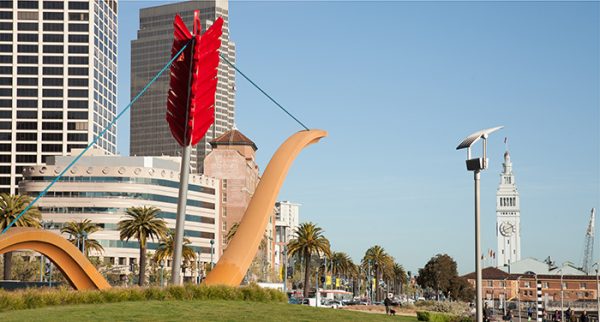
A recent warm and sunny spring morning, I found myself contemplating my good fortune to live in beautiful San Francisco, as I walked back from the Ferry Building along the Embarcadero, pulling a cartload of fresh produce from its famous Saturday Farmers’ Market. But soon my reverie was clouded by less happy thoughts. Was I feeling breathless now, because I was merely out of shape? Or was the tightness in my chest caused by too much ozone in the air? Or was that sensation due to the particulate pollution that was spewing out of the speeding cars on this busy thoroughfare?
When it comes to the quality of its air, beautiful San Francisco, (as I had just learned from the American Lung Association’s State of the Air 2018 report), is one of the worst offenders in our nation. And while our city can be proud that its conservation efforts have reduced pollution from particle emissions, its ozone pollution has become worse – essentially erasing any gains.
Ozone pollution is directly linked to climate change, because warmer temperatures favor the sun’s ability to degrade some airborne pollutants to form ozone.
Climate Change Bodes Ill For Health
Just a few days earlier, I had been in Washington D.C. to attend a conference on climate change, hosted by the newly established Medical Society Consortium on Climate and Health. The Consortium – whose members include more than 20 professional medical societies, representing nearly half of American physicians – offers a stark warning:
Climate change is already making Americans sick, and this will only get worse in the decades to come.
As we Californians learned from the forest fires of 2017, which devastated some of Santa Barbara’s and Sonoma County’s most elegant suburbs – anyone can be a victim of climate change. Yet, it is unfortunately true that some people will bear the brunt. The poor, as well as the young and the old, pregnant women, and those individuals with pre-existing lung and cardiac disease – they are at greatest risk for the health consequences of climate change.
The conference offered an in depth survey of the what to expect on the health front from climate change, along with a host of strategies to reduce polluting emissions and shift to clean, renewable energy sources. I had gone to the conference as a representative from dermatology, and, while I learned a great deal about the impact of climate change on many aspects of health, there was actually no discussion of skin and its vulnerabilities.
What About Climate Change And The Skin?
No discussion of skin? This struck me as odd, because if there ever were an organ exposed to the environment, surely it would be the skin!
There it lies – as our readers well know – providing the barrier between the world inside and that without. Skin is at work every minute of every day, holding our water in and keeping the bad stuff out.
So, why had skin and its problems not made it onto this conference’s agenda?
Could it be that skin is just totally impervious? No harmful pollutants can make it past its super-fantastic fortifications? That seemed unlikely from what I knew about skin’s most admirable, but, also, most ‘human’ shield. Its barrier capacity, I knew, was outstanding – but, I also knew that it was not absolutely perfect.
You need to get up to speed, I told myself. And so, upon returning home, I resolved to learn more about how skin was faring, as our climate warms, as extreme weather events become more frequent and more severe, and as pollution from fossil fuels baths its surfaces. In a series of article to follow, we will lead you down this discovery lane, so that our readers, too, can learn how climate change is affecting their skin. Stay tuned here.
Leave a Reply